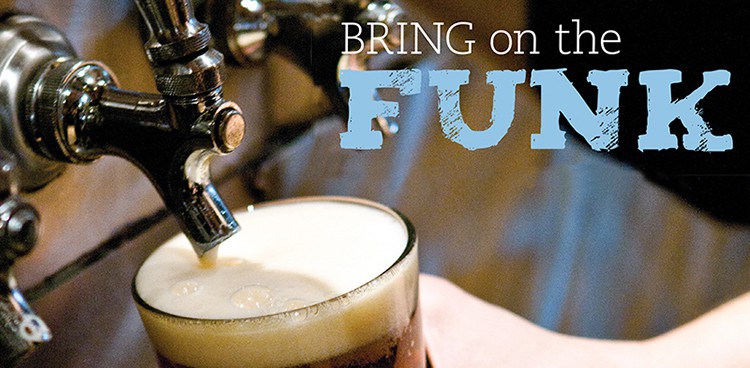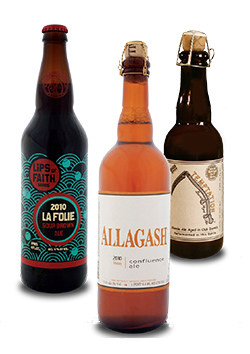
Beer history tells us that the first brewers had very little to no concept of yeast. Belgians would boil up some grains and leave the resulting liquid (called wort) in large open-topped vessels to sit overnight. And before calling it a day, they’d open all the windows of the brewery—an invitation for any airborne microflora to come feast on the sweet wort. In the morning, fermentation would have begun, and after a few weeks of aging in oak barrels, they’d have a sour, fruity, tart, acidic start to a refreshing beer.
While that beverage would certainly find a home in Belgium—it’s called lambic and is still made in traditional form—most brewers would soon learn that it was in their best interest to keep clear of those wild yeasts. After all, once certain microbes are welcomed through the doors, it can be awfully difficult to keep those funky, sour characteristics from making their way into everything a brewery does. English, German, and eventually American brewers would choose instead to stick to the cultivated yeasts that reliably produced the ales and lagers their customers had grown so accustomed to.
As time went on and scientific knowledge caught up to microbiology, brewers were able to better understand the various types of yeast strains available to them. In 1904, while exploring why certain beers continued to spoil, an employee of the Danish brewery Carlsberg stumbled upon a strain of yeast called Brettanomyces (or Brett). This was the little guy imparting barnyardy aromas that didn’t mesh very well with English ale.
If unintentional, the presence of Brett and certain types of bacteria in beer is still considered a defect in most styles outside Belgium. However, the American craft-brewing renaissance and ever-evolving American palate have created a landscape where funky, sour beers are enjoying a healthy resurgence. It’s a great moment when beers with sensory characteristics such as “horse blanket” and “sweaty saddle” are actually sought after in the United States. Breweries around the country are now purposely introducing wild yeast into their beers—something that would have been sacrilegious just 50 years ago.
Another growing trend involves aging beer in oak barrels—some previously used to age wine. Once Brett makes its way into the porous wood of an oak barrel, it’s likely to stay there for a long, long time. Some breweries will solely use Brett to ferment a beer, while others will allow yeast in the wood to create a second fermentation. Wood barrels are also home to such bacteria as Pediococcus and Lactobacillus, both of which convert sugars into lactic acid, producing sour and tart notes in beer.
For the past ten years or so, American-made wild beers have grown from having a cult following to being held in high reverence in the foodie scene. And in no place do these beers find a better home than next to an artisan cheese that can stand up to their intense flavors and aromas. At last, funk is in fashion.
Russian River Temptation & Cato Corner Farm Hooligan
Vinnie and Natalie Cilurzo are geographically predisposed to making sour beers. You see, their aptly named Russian River Brewing Co. is located—where else—in the midst of California’s wine country. Lots of vineyards equals lots of wine barrels. And for the past ten years, the Cilurzos have used their neighbor’s spent barrels to age a collection of wild beers that are renowned around the country. Temptation, a Belgian blond ale, spends a full year in French oak Chardonnay barrels with Brett, leaving the beer with fruity and woodsy characteristics. The beer also undergoes a second fermentation in the bottle, providing a bright funky effervescence. And those bubbles are going to come in handy when pairing Temptation with Hooligan, a stinky washed-rind cheese from Cato Corner Farm in Connecticut. The beer’s carbonation lifts the cheese’s creamy paste from your palate. The pungency of both beer and cheese mingle, then leave your palate to enjoy a subtle hint of fruit at the finish.
Allagash Confluence & Dancing Cow Farmstead Bourrée
The proprietary Belgian yeast Allagash Brewing Co. uses to make their flagship white ale provides a perfect canvas on which to introduce wild yeast and build supercomplex flavors and aromas. Allagash Confluence utilizes both the brewery’s house Belgian yeast strain and a strain of Brett they’ve been propagating over the years. The result is a lovely mixture of big fruity flavors and aromas—pear always seems to shine—with more nuanced tones of funk. Confluence balances complex malt sweetness and a more traditional European hop profile. The modest carbonation of this beer is ideal when paired with a cheese such as Bourrée from Dancing Cow Farm. The grassy flavors and assertive aromas on the washed rind cry out for the beer’s blend of earthy hops and ripe fruitiness.
New Belgium La Folie & Haystack Mountain Red Cloud
Replicating the classic sour beers of the Flanders region of Belgium is no easy task. These sour red and brown ales must enjoy a healthy stint in French oak before the wood’s natural bacteria can impart the tart fruitiness that defines the style. In their quest to craft a sour red of their own, New Belgium Brewing Co. enlisted the help of a brewer from the historic Belgian brewery Rodenbach. The resulting La Folie pays the finest homage to the style that any American brewer makes today. After hanging in the brewery’s French oak tanks for one to three years, the beer comes out superdry with hints of sour apple and a distinct acidic finish. When paired with Red Cloud, an aged goat’s milk cheese from New Belgium’s neighboring Haystack Mountain Goat Dairy, the beer plays nicely with the cheese’s rich tanginess. Sixty days of aging gives this washed-rind cheese an intense flavor that stands up to what is a truly remarkable style of beer.
Feature Photo Credit: Kurt Brownell





